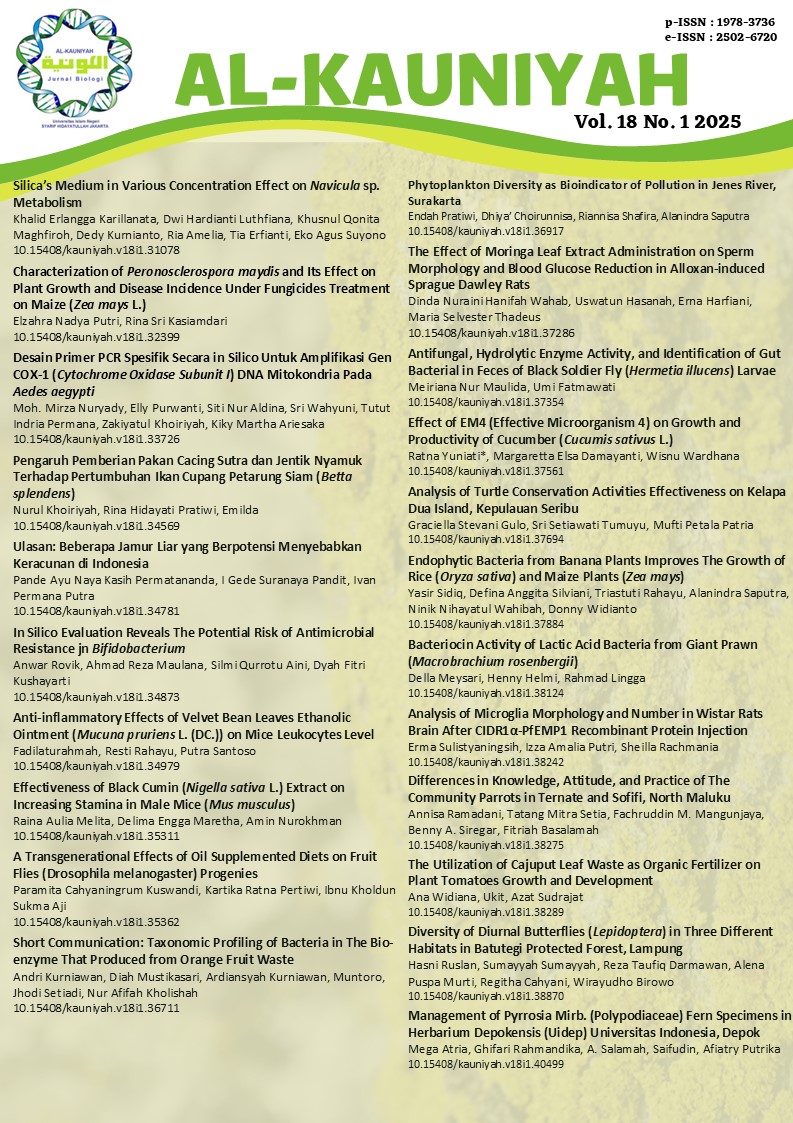Diversity of Diurnal Butterflies (Lepidoptera) in Three Different Habitats in Batutegi Protected Forest, Lampung
DOI:
https://doi.org/10.15408/kauniyah.v1i1.38870Keywords:
Batutegi Protected Forest, Butterfly, Diversity, Hutan Lindung Batutegi, Keanekaragaman, Kupu-kupuAbstract
Abstract
Batutegi protected forest has various ecosystems that are habitat for butterfly species despite being largely unexplored. This study aimed to investigate the diversity of diurnal butterflies in three different habitats of Batutegi Protected Forest, Lampung. Sampling using exploration methods was conducted in forest, river, and swamp habitat. The results showed that swamp habitat had 28 species, river habitat had 19 species, and forest habitat had 20 species. Shannon-Wiener diversity index for all habitat was at moderate level. Hutchinson's t-test results showed diversity index between three habitats was significantly different. Evenness index was at high level. The Nymphalidae family had the greatest number of species and individuals, while Lycaenidae and Riodinidae had the least. Eurema hecabe was found the highest in swamp vegetation. Cupha erymanthis was found the highest in river vegetation. Euthalia monina was found the highest in forest vegetation. Two protected species, Trogonoptera brookiana and Troides helena, were observed. Butterfly diversity was affected by habitat condition. This study can serve as fundamental reference in determining vegetation suitability for stabilizing Batutegi Protected Forest for educational and ecotourism purposes.
Abstrak
Hutan Lindung Batutegi memiliki beragam ekosistem yang menjadi habitat spesies kupu-kupu. Penelitian ini bertujuan untuk mengetahui keanekaragaman jenis kupu-kupu di tiga habitat Hutan Lindung Batutegi, Lampung. Pengambilan data dilakukan dengan metode eksplorasi di habitat rawa, sungai dan hutan. Jumlah spesies kupu-kupu ditemukan terbanyak pada habitat rawa sebanyak 28 spesies, spesies kupu-kupu di habitat hutan sebanyak 20 spesies, dan di habitat sungai sebanyak 19 spesies. Komposisi spesies kupu-kupu yang terdapat di habitat rawa dan sungai memiliki tingkat kesamaan yang tinggi. Indeks keanekaragaman kupu-kupu pada tiga habitat tergolong sedang. Hasil uji Hutchinson menunjukkan perbedaan bermakna antar habitat. Indeks kemerataan kupu-kupu di tiga habitat bernilai tinggi. Famili Nymphalidae memiliki spesies dan individu terbanyak, sedangkan famili Lycaenidae dan Riodinidae paling sedikit. Eurema hecabe ditemukan terbanyak di habitat rawa. Cupha erymanthis ditemukan terbanyak di habitat sungai. Euthalia monina ditemukan terbanyak di habitat hutan. Terdapat dua spesies kupu-kupu yang dilindungi, yaitu Troides helena dan Trogonoptera brookiana. Keanekaragaman kupu-kupu dipengaruhi oleh kondisi habitat. Penelitian ini dapat digunakan sebagai dasar pertimbangan kesesuaian habitat yang perlu dipertahankan untuk menyeimbangkan daerah kawasan Hutan Lindung Batutegi sebagai sarana edukasi dan ekowisata.
References
Afandi, A., Purwatiningsih, P., & Prihatin, J. (2023). Keanekaragaman kupu-kupu (Lepidoptera: Rhopalocera) di Segitiga Ranu Lumajang, Jawa Timur. Jurnal ILMU DASAR, 24(1), 37-50.
Agustiningrum, A. M., Sulisetijono, S., & Rahayu, S. E. (2022). Preferensi inang Familia Nymphalidae di Kawasan Coban Rais Kota Batu. Jurnal Ilmu Hayat, 6(1), 33-41. doi: 10.17977/um061v6i12022p33-41.
Aprillia, I., Iqbal, M., Setiawan, D., Yustian, I., Pragustiandi, G., & Salaki, L. (2020). Kupu-kupu Sembilang Dangku. Bogor: Zoological Society of London Indonesia.
Aziz, R. M. (2022). Ekonomi pertanian era pandemi dengan metafora kupu-kupu berkode r12 dan r47 dalam ibadah. Jurnal Agrotek UMMAT, 9(2), 105-116.
Kirton, L. G. (2014). A naturalist’s guide to the butterflies of Peninsular Malaysia, Singapore and Thailand. Singapore: John Beaufoy Publishing.
Kurniawan, B., Apriani, R. R., & Cahayu, S. (2020). Keanekaragaman spesies kupu-kupu (Lepidoptera) pada habitat eko-wisata Taman Bunga Merangin Garden Bangko Jambi. Al-Hayat: Journal of Biology and Applied Biology, 3(1), 1. doi: 10.21580/ah.v3i1.6064.
Mtui, D. T., Ogutu, J. O., Okick, R. E., & Newmark, W. D. (2022). Elevational distribution of montane Afrotropical butterflies is influenced by seasonality and habitat structure. PLoS ONE, 17(7 July). doi: 10.1371/journal.pone.0270769.
Mulyono, S. F. S., & Kurniawan, I. S. (2022). Abundance of ordo Lepidoptera in the land conversion of Ciwidey pine forest. Journal of Biology and Applied Biology, 5(2), 117-126. doi: 10.21580/ah.v5i2.12684.
Mutiasari, N. R., Widyasari, N., Putri, F. K. E., Wanti, I. A., Djamahar, R., & Sartono, N. (2021). Keanekaragaman kupu-kupu (Lepidoptera) di Danau Kenanga, Universitas Indonesia Depok, Jawa Barat, Indonesia. Proceeding of Biology Education, 4(1), 63-71. doi: 10.21009/pbe.4-1.6.
Nurhayati. (2021). Keanekaragaman jenis kupu-kupu (Lepidoptera) di Kawasan Air Terjun Kuta Malaka Kabupaten Aceh Besar (Undergraduate thesis, Universitas Islam Negeri Ar-Raniry, Aceh, Indonesia). Retrieved from https://repository.ar-raniry.ac.id/id/eprint/16744.
Paliama, H. G., Latumahina, F. S., & Wattimena, C. M. A. (2022). Keanekaragaman serangga dalam kawasan hutan mangrove di Desa Ihamahu. Jurnal Tengkawang, 12(1), 94-104.
Peggie, D., & Amir, M. M. S. (2006). Practical guide to the butterflies of Bogor Botanic Garden: Panduan praktis kupu-kupu di Kebun Raya Bogor. Bogor: Pusat Penelitian Biologi, LIPI and Nagao Natural Environment Foundation.
Peggie, D., Supadi, S., Guntoro, G., & Rasyidi, M. (2021). Can Troides helena and Pachliopta adamas co-exist? A perspective from the butterfly breeding facility, Cibinong Science Center, Indonesia. TREUBIA, 48(2), 129-140. doi: 10.14203/treubia.v48i2.4257.
Ramadhanti, C. (2022). Struktur komunitas Rhopalocera di Resort Way Sekampung Hutan Lindung Batutegi Provinsi Lampung (Undergraduate thesis). Universitas Lampung, Lampung, Indonesia.
Ruslan, H., Yenisbar, Y., & Satiyo, A. (2023). Correlation of butterfly (Lepidoptera : Papillionoidea) with flowering plant in the Bodogol nature conservation education. Journal of Tropical Biodiversity, 3(2), 1-13.
Tiple, A. D., Khurad, A. M., & Dennis, R. L. H. (2011). Butterfly larval host plant use in a tropical urban context: Life history associations, herbivory, and landscape factors. Journal of Insect Science, 11(May 2014). doi: 10.1673/031.011.6501.
Weei, G. C., & Mun, S. C. K. (2008). A field guide to the butterflies of Singapore. Singapore: Nature Society.

